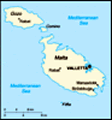Advertisement
Published: June 11th 2010
Today we set out in search of history and ended up a little disappointed, although we did have a good day.
We headed off to Birgu, which was renamed Vittoriosa after the Great Siege of Malta in 1565. Birgu was where the Knights settled in Malta after they were kicked out of Rhodes by the Muslims in 1530. To protect themselves they turned the town into a fortified city to protect against further attacks from the Turks, which in the end turned out to be very beneficial.
On entering the city we walked down towards the main square and on the right we visited the Inquisitors Palace. This building was originally the Law Courts of the Knights but after they moved to Valletta in 1571 it became the Inquisitors Palace, administering religious law for over 160 years.
The building is now a museum and contains many old cells which still bear the markings that former prisoners scratched on the walls. The lower part of the building contains the cells, which lead up a separate staircase to the courts where prisoners were handed their fate by the inquisitors. On the upper level of the palace are the private rooms
of the inquisitors where all the rooms and halls having amazing tapestries all around them. In the great hall the tapestries depict the coats of arms off all the inquisitors that resided in the palace, still with empty spaces for any future people.
After we left here, we headed to the square as there is a small church museum which contains then sword and hat of Grand Master Jean de la Vallette, the builder of Valletta. This small museum is near The Church of St Lawrence and has a sign on the wall that states the Rhodians (Knights of Rhodes) prayed there in 1530. However, the museum is only open until noon and we didn’t get there until about 1.30pm.
We then went for a walk along where the Royal Navy base used to be which has now been turned into a yacht marina and food paradise. We had a lovely lunch and then went for more walks down to the end to go into Fort St Angelo. Disappointed.
There are two places on the island of Malta that are the most historic events to have happened here. During the Great Siege of Malta, the Turks first
attacked Fort St Elmo where Valletta now stands. They expected to take the fort within a week but the Knights held out for over 30 days. Both sides suffered great casualties but none more so than the Turks who lost so many men that they were unable to have enough troops to take Fort St Angelo. Eventually, relief for the Knights came from Sicily and the Turks retreated forever.
The problem is that both Fort St Elmo and Fort St Angelo are not open to the public in spite of their historical interest to the public. They have also allowed modern flats to be built on the landward side of Fort St Angelo which are not sympathetic with the other architecture in the general area. Hopefully in the future both these sites will be open to the public to fully understand the achievements of the Knights.
After trying unsuccessfully to get into Fort St Angelo we then went to the Maritime Museum, which in itself was very interesting. This building was built on the site of the Order’s arsenal but was rebuilt in 1841 as the Royal Navy’s bakery. The bell tower was also used to enable the
naval ships in port at the time to synchronise their clocks.
The displays in the museum are very extensive covering both military and civil maritime objects from the Knights through to the modern day. There is a very good display of items from the British era. On the ground level are various engines and also whilst renovating the building to be used as the museum they found the original mill grindstones below the motor.
After we finished in the museum we went to the Church of St Lawrence. There has been a church on this site for 1000 years although the present one was built in the 17th century. The parish church on this site was the first church used by the Knights and was their main church until the move to Valletta in 1571. Like all the other churches built around this time, the interior is a baroque design and is highly decorated.
After visiting the church, we decided to get a water taxi over to Valletta to get the bus back to Mellieha. The crossing was made in a traditional dghajsa, although these days they are powered by an outboard motor rather than just by
the oarsman rowing from a standing up position. The trip took about ten minutes and was a pleasant way to finish another day of sightseeing.
Advertisement
Tot: 0.101s; Tpl: 0.02s; cc: 9; qc: 33; dbt: 0.0637s; 1; m:domysql w:travelblog (10.17.0.13); sld: 1;
; mem: 1.1mb
























Sophie
non-member comment
...
Yaxi? Is that a Maltese term? hehehehe xoxox miss you guys!!!